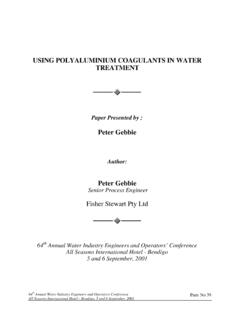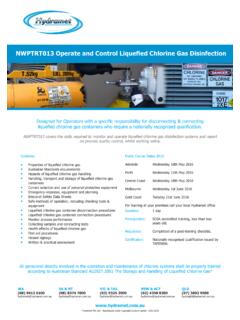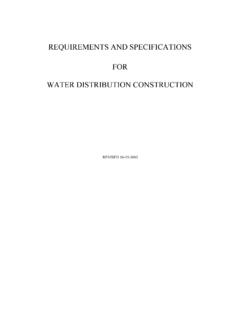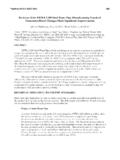Transcription of Revision of AWWA C651-14: The Water Main Disinfection …
1 REILLEY ET AL. | 107:10 JOURNAL awwa | OCTOBER 2015 33On Feb. 1, 2015, awwa issued the updated ANSI/ awwa c651 -14 standard, Disinfecting Water Mains, a result of the review that awwa standards must go through every five years. This newly revised standard helps utilities, engineers, and contrac-tors better understand the specifications for chlorination required by the standard and interpret the procedures necessary to properly complete chlorination c651 has undergone major changes to take into account new technologies and the increases in requirements for testing, flushing, and pro-tection of the environment; these requirements are reflected in current regula-tions and changing project specifications set by state and federal authorities. The changes also include an assessment of Water main breaks to determine the appropriate procedures for the risks involved.
2 A REVIEW OF awwa standards IS REQUIRED EVERY FIVE YEARS; awwa c651 S revisions ADD CLARIFICATION AND REFLECT NEW TECHNOLOGIES, MANDATES, AND RESEARCH REILLEY, GARY A. BURLINGAME,AND ROBERT GORDHAMER Revision of awwa C651-14: The Water main Disinfection Standard2015 American Water Works AssociationWHY THESE CHANGES WERE MADEIn conducting the review for this update of awwa c651 , the commit-tee responsible for its development wanted to incorporate new findings of the Water Research Foundation (WRF). WRF has funded research on main Disinfection and repair prac-tices over the past 20 years to improve the science behind those practices recommended in awwa standards . With the growing concern about aging infrastructure and Water main failures in the United States, a WRF study that focused on best practices for main breaks Effective Microbial Control Strategies for main Breaks and Depressurization was completed (Kirmeyer et al.)
3 2014), and those findings were incorpo-rated into the c651 update. The US Environmental Protection Agency s issue paper, New or Repaired Water Mains, provides jus-tification for the need to implement proper pipeline Disinfection proce-dures and for careful consideration of sanitary conditions during pipe-line installation and repairs ( awwa & EESI 2002). THE MAJOR REVISIONSC larification separating the methods of chlorination and addition of a fourth method. In awwa c651 there had been some confusion regarding the original section , Methods of Chlorination. All methods were lumped together, which caused misunderstandings in how to use this section. By separating each method, individual requirements can be highlighted. In addition, a fourth method the spray method was added to better accommodate large-diameter of the difference between requirements for new and repaired mains.
4 The most significant changes are with regard to pipe repairs, which have been broken into three categories on the basis of potential for public health risk. Mains requiring repair often need to be returned to service as quickly as possible to minimize disruption to customers. Depending on the nature of the repair to be completed, sani-tary integrity can be protected in many cases with a minimum of added steps. Options are provided that take into account different-size pipes and the conditions present. The majority of Water main breaks are typically leaks or cracks that can be repaired without depressurizing the Water main . The failure point is unearthed, cleaned, and disinfected, and then a clamp is applied or another repair is made. Since the primary route of Water contamination comes from intrusion of contaminants, maintaining a pres-surized pipe while it is under repair prevents such intrusion.
5 However, when a rupture occurs, and the pipe is open to environmen-tal contamination and Water pres-sure at the break site is lost, several precautions must be taken to reduce health risks. The following catego-ries outline the differences in awwa c651 s breaks: Is the main kept pressurized throughout trenching and isola-tion of the line? Can the line remain pressurized while the leak is repaired? If so, no Disinfection or sampling is required as the sanitary integrity of the line is maintained. Must the line be depressurized to repair the break? If so, was the line kept pressurized until the leak site was excavated? In this case, disinfect all new components and flush and measure chlorine residual when the repair is complete. As long as no contamination occurred during the repair work, only flushing and veri-fying proper chlorine residual levels are necessary.
6 Did the break result in wide-spread depressurization? Or was the line depressurized before the pipe was trenched/exposed? Is contamination sus-pected or likely? If so, more must be done in terms of disin-fection and sampling to ensure protection of public health. Given the wide variety of situa-tions and conditions faced by field personnel when dealing with pipe-line repairs and the importance of protecting our drinking Water sup-ply, this update provides guidance on how to assess the proper options for completing those repairs, with the priority being on protecting public health. Section added for large-diameter transmission lines: The prior c651 standard did not specifically address alternative chlorination methods for large-diameter pipes. This update pro-vides flexibility by allowing more appropriate flushing pro-cedures as well as providing 34 OCTOBER 2015 | JOURNAL awwa 107:10 | REILLEY ET American Water Works AssociationREILLEY ET AL.
7 | 107:10 JOURNAL awwa | OCTOBER 2015 35additional options for disinfec-tion ( , a spray method). For large-diameter transmission mains, spray Disinfection may be used per ANSI/ awwa C652, Section ( Disinfection of Water Storage Facilities, Chlori-nation Method 2). Once a pipe is cleaned, the pipe surfaces are sprayed, followed by a 30-min wait period before filling the line and rates: Scour rates for most pipes have been increased to fps as a result of testing done through the WRF study, which demonstrated that a higher rate is needed to bet-ter remove sand and debris. Sand and debris can cause two prob-lems: (1) create excess chlorine demand, thus consuming the dis-infectant before it can eliminate all microbes and (2) hide microbes from flushing and Disinfection . The flow rate is based on a mini-mum Water flow velocity.
8 If flows are not possible, pigging or flush-ing at the maximum expected flow rate for two to three volumes of Water may be : The requirement for bacterio-logical sampling in new mains has been revised from two sets of samples taken 24 h apart to add two options for two sets of sam-ples: (1) option A samples are taken 16 h apart and (2) option B samples are taken 15 min apart after a 16-h rest period. The reason for two samples is that 100-mL samples are a frac-tion of the volume of Water in the pipe; thus, such sampling can miss pockets of dirt and mi -crobes. The reason for a holding time before or between sampling is to test for Water quality dete-rioration over time a signal that the line is contaminated. Bacteriological sampling for re paired mains depends on the nature of each break and repair. Note that more serious pipe breaks must follow the Disinfection and bacterial sampling procedures applicable to new mains.
9 In addition to bacteriological sampling, awwa c651 sug-gests considering other Water quality tests such as turbidity, pH, and chlorine residual. A combination of tests can indi-cate reasons for degradations of Water and pressure testing: This process specifies the use of potable Water only for flushing and pressure testing. This process prohibits highly chlorinated Water use in high-rate flushing as most dechlorina-tion equipment is not designed to accommodate such flows at such high levels of chlorine. Dechlorination: References to the new awwa C655 were added to provide direction on proper dechlorina-tion and disposal of heavily chlorinated 651, the updated Disinfection of Water Mains stan-dard, incorporates findings from a WRF project and seeks to clarify steps to take depending on the nature of the work.
10 Given the wide range of projects and repairs, these updates accommodate the variety of conditions encountered and provide a means to assess the risk and to identify the appropriate level of dis-infection and sampling. ABOUT THE AUTHORSS ince 1996, Betsy Reilley has worked with the Massachusetts Water Resources Authority; 100 First Ave., Boston, MA 02129 USA; As the director of environmental quality, she is responsible for sampling, reporting, and compliance programs for the drinking Water and wastewater systems. Since 2006 Reilley has served on the awwa Disinfection of Facilities Committee and since 2010 has served as its chair. Gary A. Burlingame is laboratory director at the Bureau of Laboratory Services at the Philadelphia Water Department (Pa.). Robert Gordhamer is president and chief executive officer of Measurement Technologies Inc. in Redmond, & EESI (Economic and Engineering Services Inc.)











